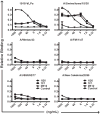Neutralizing antibodies derived from the B cells of 1918 influenza pandemic survivors
- PMID: 18716625
- PMCID: PMC2848880
- DOI: 10.1038/nature07231
Neutralizing antibodies derived from the B cells of 1918 influenza pandemic survivors
Erratum in
- Nature. 2012 Oct 25;490(7421):570
Abstract
Investigation of the human antibody response to influenza virus infection has been largely limited to serology, with relatively little analysis at the molecular level. The 1918 H1N1 influenza virus pandemic was the most severe of the modern era. Recent work has recovered the gene sequences of this unusual strain, so that the 1918 pandemic virus could be reconstituted to display its unique virulence phenotypes. However, little is known about adaptive immunity to this virus. We took advantage of the 1918 virus sequencing and the resultant production of recombinant 1918 haemagglutinin (HA) protein antigen to characterize at the clonal level neutralizing antibodies induced by natural exposure of survivors to the 1918 pandemic virus. Here we show that of the 32 individuals tested that were born in or before 1915, each showed seroreactivity with the 1918 virus, nearly 90 years after the pandemic. Seven of the eight donor samples tested had circulating B cells that secreted antibodies that bound the 1918 HA. We isolated B cells from subjects and generated five monoclonal antibodies that showed potent neutralizing activity against 1918 virus from three separate donors. These antibodies also cross-reacted with the genetically similar HA of a 1930 swine H1N1 influenza strain, but did not cross-react with HAs of more contemporary human influenza viruses. The antibody genes had an unusually high degree of somatic mutation. The antibodies bound to the 1918 HA protein with high affinity, had exceptional virus-neutralizing potency and protected mice from lethal infection. Isolation of viruses that escaped inhibition suggested that the antibodies recognize classical antigenic sites on the HA surface. Thus, these studies demonstrate that survivors of the 1918 influenza pandemic possess highly functional, virus-neutralizing antibodies to this uniquely virulent virus, and that humans can sustain circulating B memory cells to viruses for many decades after exposure-well into the tenth decade of life.
Conflict of interest statement
The authors declare no competing financial interests.
Figures

Similar articles
-
Heterosubtypic neutralizing monoclonal antibodies cross-protective against H5N1 and H1N1 recovered from human IgM+ memory B cells.PLoS One. 2008;3(12):e3942. doi: 10.1371/journal.pone.0003942. Epub 2008 Dec 16. PLoS One. 2008. PMID: 19079604 Free PMC article.
-
Potential Role of Nonneutralizing IgA Antibodies in Cross-Protective Immunity against Influenza A Viruses of Multiple Hemagglutinin Subtypes.J Virol. 2020 Jun 1;94(12):e00408-20. doi: 10.1128/JVI.00408-20. Print 2020 Jun 1. J Virol. 2020. PMID: 32269119 Free PMC article.
-
Pre-existing immunity with high neutralizing activity to 2009 pandemic H1N1 influenza virus in Shanghai population.PLoS One. 2013;8(3):e58810. doi: 10.1371/journal.pone.0058810. Epub 2013 Mar 19. PLoS One. 2013. PMID: 23527030 Free PMC article.
-
Antibodies against swine influenza virus neutralize the pandemic influenza virus A/H1N1.Mol Med Rep. 2011 Mar-Apr;4(2):209-14. doi: 10.3892/mmr.2011.410. Epub 2011 Jan 3. Mol Med Rep. 2011. PMID: 21468553
-
Development of neutralizing monoclonal antibodies against the pandemic H1N1 virus (2009) using plasmid DNA immunogen.J Virol Methods. 2014 Jan;195:54-62. doi: 10.1016/j.jviromet.2013.08.038. Epub 2013 Sep 20. J Virol Methods. 2014. PMID: 24060631
Cited by
-
Pathogenesis of pandemic influenza A (H1N1) and triple-reassortant swine influenza A (H1) viruses in mice.J Virol. 2010 May;84(9):4194-203. doi: 10.1128/JVI.02742-09. Epub 2010 Feb 24. J Virol. 2010. PMID: 20181710 Free PMC article.
-
Analysis of the conserved protective epitopes of hemagglutinin on influenza A viruses.Front Immunol. 2023 Feb 17;14:1086297. doi: 10.3389/fimmu.2023.1086297. eCollection 2023. Front Immunol. 2023. PMID: 36875062 Free PMC article. Review.
-
Human monoclonal antibodies isolated from a primary pneumococcal conjugate Vaccinee demonstrates the expansion of an antigen-driven Hypermutated memory B cell response.BMC Infect Dis. 2018 Dec 4;18(1):613. doi: 10.1186/s12879-018-3517-7. BMC Infect Dis. 2018. PMID: 30509199 Free PMC article.
-
B cell biology: an overview.Curr Allergy Asthma Rep. 2014 May;14(5):434. doi: 10.1007/s11882-014-0434-8. Curr Allergy Asthma Rep. 2014. PMID: 24633618 Review.
-
Antigenic drift and immunity gap explain reduction in protective responses against influenza A(H1N1)pdm09 and A(H3N2) viruses during the COVID-19 pandemic: a cross-sectional study of human sera collected in 2019, 2021, 2022, and 2023.Virol J. 2024 Mar 6;21(1):57. doi: 10.1186/s12985-024-02326-w. Virol J. 2024. PMID: 38448981 Free PMC article.
References
-
- Johnson NP, Mueller J. Updating the accounts: global mortality of the 1918-1920 “Spanish” influenza pandemic. Bull Hist Med. 2002;76:105–115. - PubMed
-
- Taubenberger JK, et al. Characterization of the 1918 influenza virus polymerase genes. Nature. 2005;437:889–893. - PubMed
-
- Tumpey TM, et al. Characterization of the reconstructed 1918 Spanish influenza pandemic virus. Science. 2005;310:77–80. - PubMed
-
- Kobasa D, et al. Aberrant innate immune response in lethal infection of macaques with the 1918 influenza virus. Nature. 2007;445:319–323. - PubMed
Publication types
MeSH terms
Substances
Associated data
- Actions
- Actions
- Actions
- Actions
- Actions
- Actions
- Actions
- Actions
- Actions
- Actions
Grants and funding
- AI42266/AI/NIAID NIH HHS/United States
- U19 AI057229/AI/NIAID NIH HHS/United States
- U54 AI57158/AI/NIAID NIH HHS/United States
- R01 AI042266/AI/NIAID NIH HHS/United States
- U19 AI62623/AI/NIAID NIH HHS/United States
- R37 AI042266/AI/NIAID NIH HHS/United States
- U54 AI057158/AI/NIAID NIH HHS/United States
- CA55896/CA/NCI NIH HHS/United States
- AI057158/AI/NIAID NIH HHS/United States
- R01 AI048677/AI/NIAID NIH HHS/United States
- U19 AI062623/AI/NIAID NIH HHS/United States
- U54 AI057157/AI/NIAID NIH HHS/United States
- P01 AI058113/AI/NIAID NIH HHS/United States
LinkOut - more resources
Full Text Sources
Other Literature Sources
Medical
Molecular Biology Databases

